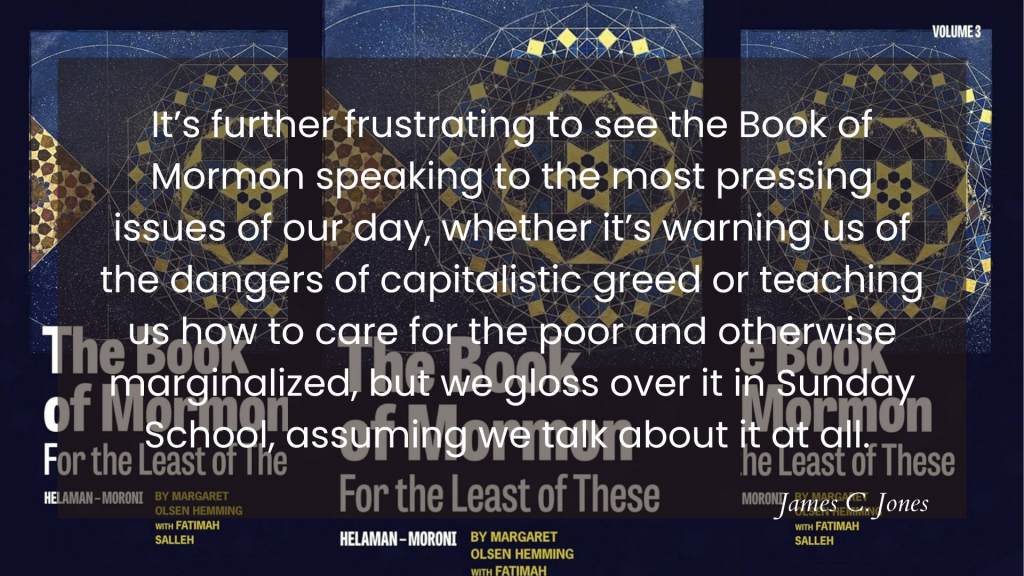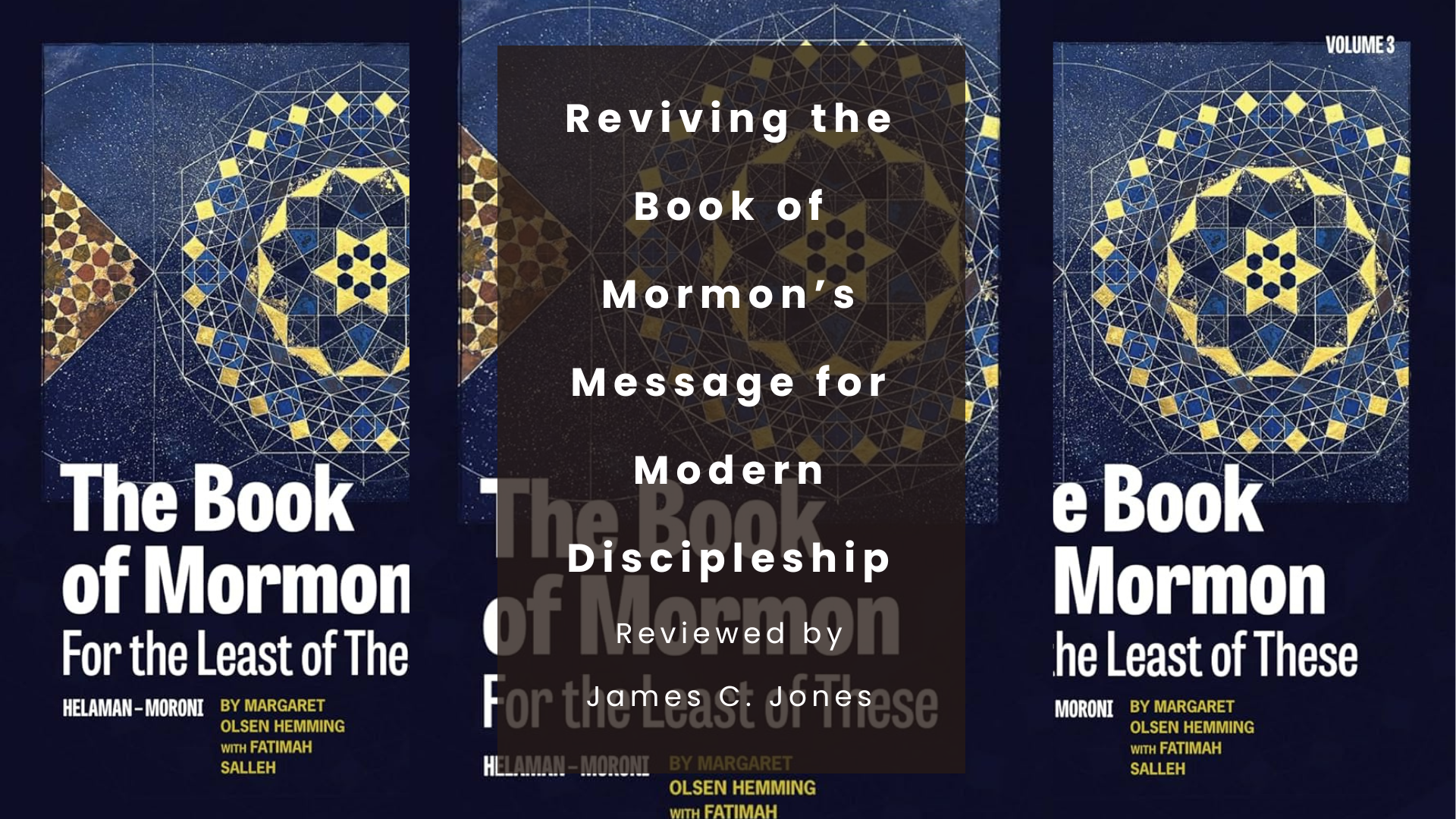Articles/Essays – Volume 58, No. 3
Reviving the Book of Mormon’s Message for Modern Discipleship | Fatimah Salleh and Margaret Olsen Hemming, The Book of Mormon for the Least of These
Too frequently, I have the experience of anxiously awaiting Sunday School to start so I can ask about a text from the week’s reading that’s relevant to what’s happening in the world, only to be disappointed in some way—usually by no one else seeing what I saw or no one else thinking that what I saw is important enough to discuss. That recurring experience is frustrating and makes me feel unseen, but more importantly, it makes our faith feel shallow. Additionally, to go to church again and again to study a sacred text unique to us, a text that gives us more of Christ’s word—a Christ whose most fundamental ethic is loving our neighbor as ourselves—and to also watch that sacred text be ignored for the rich justice text that it is, or worse, to also be utilized as a tool of oppression like the Bible, is a profoundly frustrating and exhausting experience. It’s further frustrating to see the Book of Mormon speaking to the most pressing issues of our day, whether it’s warning us of the dangers of capitalistic greed or teaching us how to care for the poor and otherwise marginalized, but we gloss over it in Sunday School, assuming we talk about it at all.
While the Come, Follow Me seminary and institute manuals are decent tools, they have demonstrated themselves multiple times to be incomplete. Enter the three-volume series The Book of Mormon for the Least of These by Rev. Dr. Fatimah Salleh and Margaret Olsen Hemming.

Many of my personal projects in LDS spaces have been geared toward mining content and conversation from our sacred texts that validates and supports the marginalized. In my opinion, there is no Book of Mormon study guide or commentary that does this better than The Book of Mormon for the Least of These. I’ll take it a step further and say that it’s arguably the best study resource for the Book of Mormon and does a better job of making the text relevant to discipleship in today’s world than any other resource. It has revitalized my love for and study of the Book of Mormon, in addition to helping me articulate the ways in which the Book of Mormon points to our wickedness, warns us of consequences, exhorts us to better, and shows us how, while also showing us the beauty and joy found in discipleship.
In the introduction to the second volume, the authors identify the Book of Mormon story as a tragic and prescient warning of what happens when people choose “their own interests over [what Martin Luther King Jr. calls] beloved community” (xv). As such, Salleh and Hemming make a concerted effort to highlight the moments in the Book of Mormon where harm is being done, especially to the marginalized, and also where it teaches us what beloved community is and how to create it. They show us how Nephi’s trauma affected his telling of his family’s story, how it affected his descendants, and how it still affects the Church of Jesus Christ of Latter-day Saints; they show us how to read the silence (or silencing) of women in the text; and they show us how true understanding of our reliance on God will result in our keeping of the second great commandment to treat the needs of others as holy. They cover a variety of other topics and issues, including allyship, identity, memory work as justice work, economic justice, how the vulnerable are used as tools of war, sex ethics, the ways that antichrists operate, and much more. What I mark as simultaneously a strength and a weakness of The Book of Mormon for the Least of These is that it does an incredible job of starting many important conversations that are simply not happening in Sunday School, but as a commentary, a “start” is about all the authors can afford. What will a greater exploration of the first half of 4 Nephi look like knowing that a concern for social justice is what enabled such long-lasting peace? What are the implications for the Church’s law of chastity considering that its primary source text for it (Alma 39) may not say what we think it says? The Book of Mormon for the Least of These contains profoundly thoughtful commentary on a variety of issues like these, but it is not designed to treat most of them in the detail that a student of the text might desire.
Still, The Book of Mormon for the Least of These is quite refreshing to me as a Mormon theologian, and it is quite accessible to the general public despite clearly being written by a pair of scholars. I most strongly recommend it to members of the Church who want to get more out of their Book of Mormon study, especially ones with a concern for social justice, which is too often omitted from the Come, Follow Me manual and our Sunday School classrooms. Having experienced a Sunday School classroom where the instructor cited these volumes, I also will specifically recommend this for Sunday School teachers.
To conclude, in our church culture that often glosses over the rich and life-giving justice messages in our texts, The Book of Mormon for the Least of These serves as a vital and refreshing corrective. By centering the voices of the least, the last, the lost, and the left out, Salleh and Olsen Hemming invite deeper and more thoughtful engagement that not only reinvigorates our study of the Book of Mormon but also reminds us of its urgent relevance to modern discipleship. If you’re like me and desperately yearning to find Christ’s call to beloved community in the Book of Mormon, this work offers both spark and substance to begin transforming how we read, understand, teach, and live the gospel of the same Christ who declared our treatment of the least of these was our treatment of him.
Fatimah Salleh and Margaret Olsen Hemming. The Book of Mormon for the Least of These. Vols. 1–3. Draper, UT: By Common Consent Press, 2020, 2022, 2023. 176–400 pp. Paperbacks: $9.70–$15.95. ISBNs: 978-1948218238, 978-1948218580, 978-1948218993


 Back to full Issue
Back to full Issue

